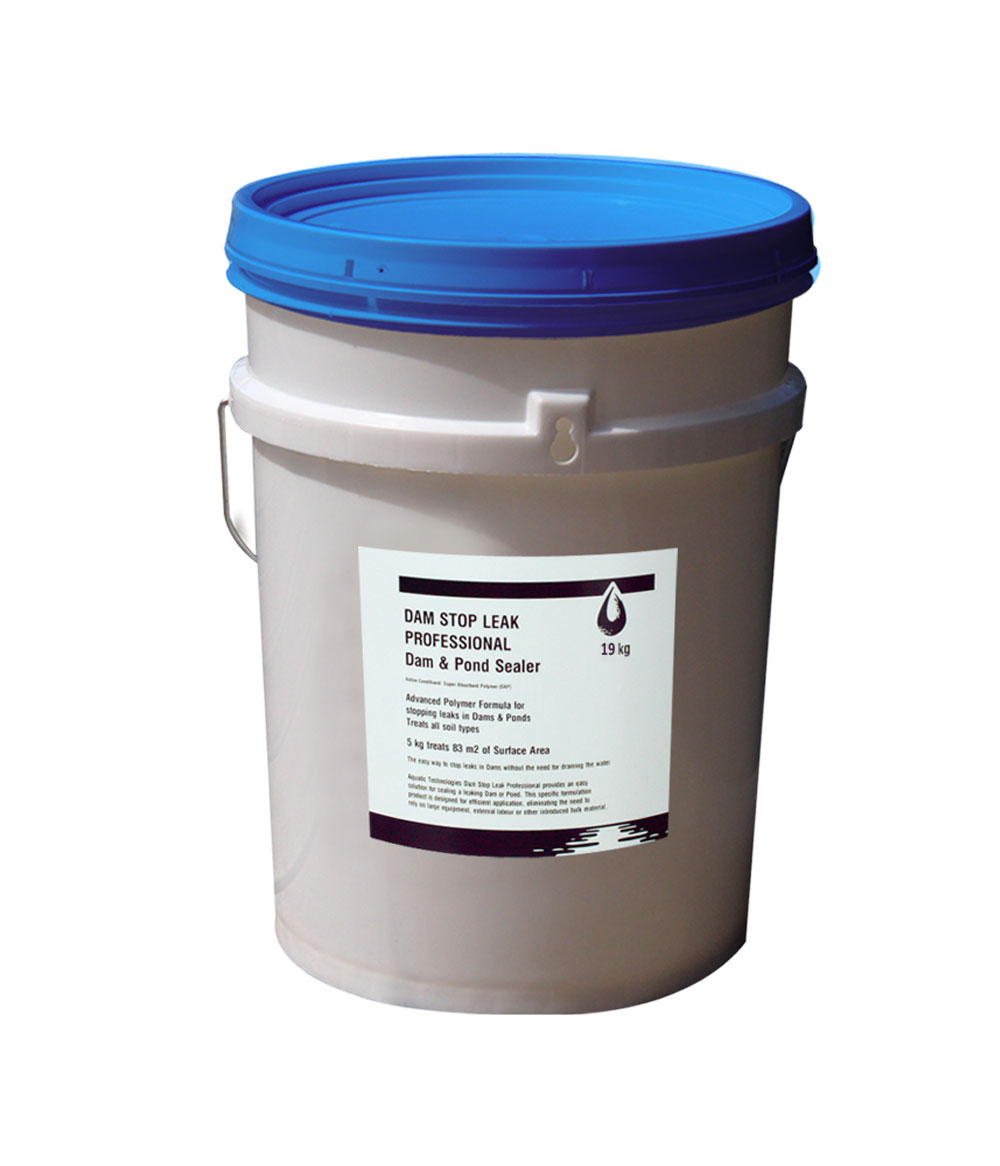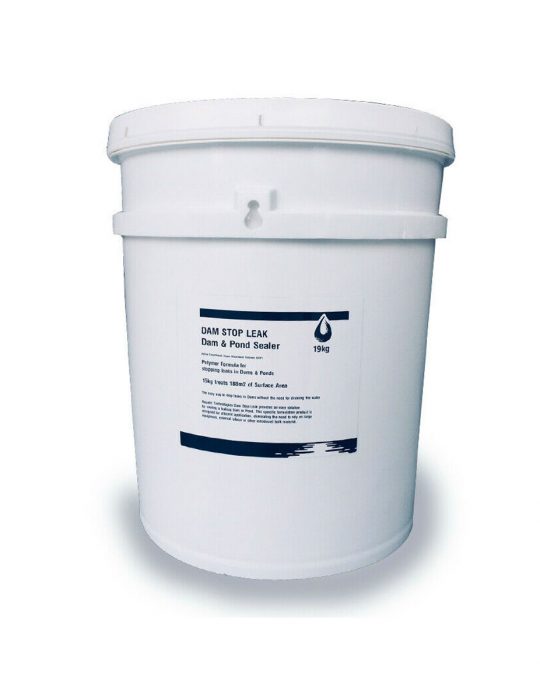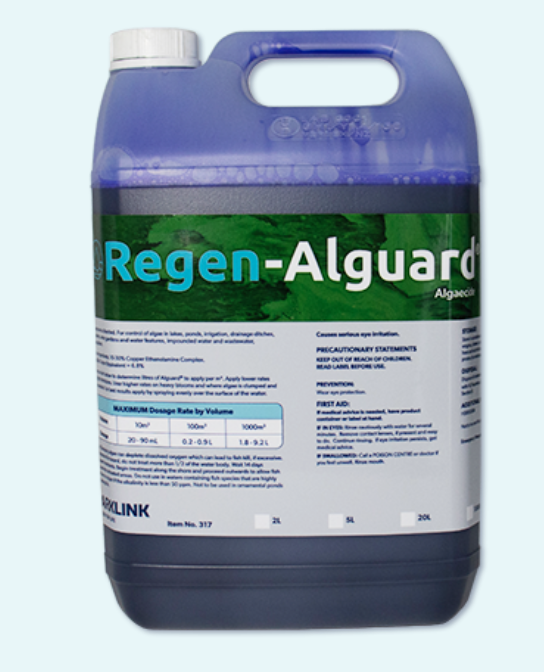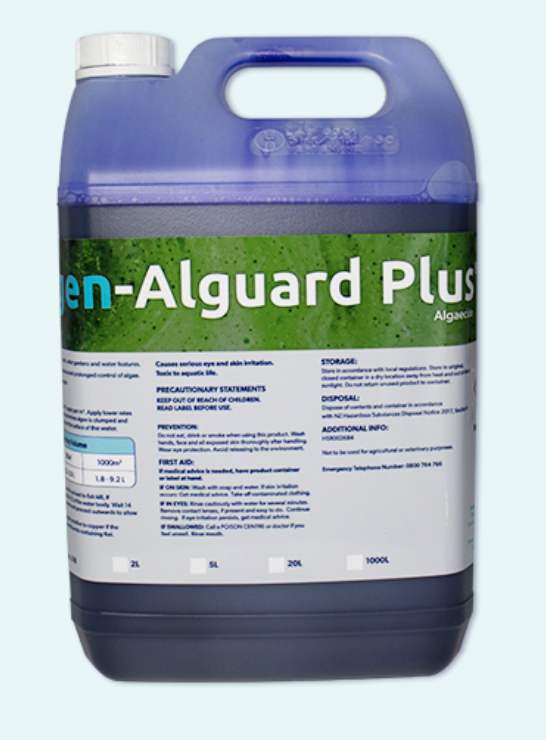Dam Stop Leak Standard is a potassium-free polymer/clay sealant that creates a permanent plug in any leaks or cracks of an earth or clay-based dam.
A commercial-grade liquid, copper-based algaecide called REGEN-Alguard® (or Alguard Plus) is used to safely, quickly, and effectively control a variety of filamentous and planktonic algae. REGEN-Alguard®, which is frequently used to manage algae in lakes, irrigation dams, decorative ponds, and other areas, contains up to 80% less copper than conventional (copper-based) algaecides. Fish, cattle, plants, pastures, and grass are not harmed by REGEN-Alguard® (when used as directed on the label).
REGEN-Alguard® works by making algae and cyanobacteria cells more vulnerable. The cells die and disintegrate into the water as a result of copper ions stopping photosynthesis. Little harm is done to aquatic organisms. Toxins that are still present biodegrade quickly. Unlike other substances, REGEN-Alguard® quickly disperses throughout the water body rather than sinking to the bottom or floating on top
A commercial-grade liquid, copper-based algaecide called REGEN-Alguard® (or Alguard Plus) is used to safely, quickly, and effectively control a variety of filamentous and planktonic algae. REGEN-Alguard®, which is frequently used to manage algae in lakes, irrigation dams, decorative ponds, and other areas, contains up to 80% less copper than conventional (copper-based) algaecides. Fish, cattle, plants, pastures, and grass are not harmed by REGEN-Alguard® (when used as directed on the label).
REGEN-Alguard® works by making algae and cyanobacteria cells more vulnerable. The cells die and disintegrate into the water as a result of copper ions stopping photosynthesis. Little harm is done to aquatic organisms. Toxins that are still present biodegrade quickly. Unlike other substances, REGEN-Alguard® quickly disperses throughout the water body rather than sinking to the bottom or floating on top.
Dam Leaks: Causes & Symptoms
Causes of Dam Leaks
Dam leaks can occur due to a variety of factors:
Soil Composition: Dams built on sandy or gravelly soils are more prone to leaks due to the porous nature of these materials.
Poor Construction: If a dam is not correctly constructed, water can easily find its way through the structural weaknesses, starting leaks and even catastrophic failures.
Vegetation Damage: Tree roots can penetrate the dam structure, causing leaks. Additionally, decaying plant matter can create voids through which water can escape.
Erosion: Wind, water stream, and rainfall can cause deterioration of the dam’s surface, leading to possible areas of leakage.
Ageing Infrastructure: Over time, environmental factors and general wear and tear can weaken the dam structure, increasing the risk of leakages.
Symptoms of Dam Leaks
Recognising the symptoms of dam leaks is crucial for timely intervention:
Water Level Changes: If the water level drops significantly without a corresponding drought or increased use from the dam, a leak might be the cause.
Wet Areas Downstream: An unusual wet or greener patch of land downstream may signal a leak.
Silt Outflows: If muddy water or silts appear at the foot or the downstream toe of the dam, there could be a leak.
Sinkholes or Voids: These could appear on the embankment or the surrounding earth area, indicating a leak under the dam structure.
Remember that dam leaks can escalate to serious problems if ignored. Regular inspection and maintenance activities, coupled with quality leak control products, can help prevent and address dam leakages effectively.
Types of Dam Leak Control Products
Various types of Dam Leak Control Products are available to address different causes of leaks and provide effective solutions. These products can be grouped into the following categories:
Dam Sealants
These chemical-based products, such as Aquatic Technologies’ ‘Dam Stop Leak Professional,’ effectively target leaks by penetrating the soil and forming a watertight seal that prevents further seepage. Easily applicable and fast-acting, dam sealants ensure efficient leak repair, significantly reducing the chances of water loss.
Liner Solutions
Liners are made of various materials like PVC, HDPE, or EPDM that create a physical barrier to prevent water from seeping through the dam’s surface[2%5E]. Available as flexible or rigid liners, they can be tailored to fit the dimensions and contours of the dam, providing a high degree of leak prevention and durability.
Bentonite Clay
Bentonite clay, composed primarily of montmorillonite, is a natural, absorbent material that swells when in contact with water and forms an impermeable barrier[1%5E]. It can be applied either by mixing with the soil or through a more direct method called “blanket installation,” which involves spreading bentonite layers over the dam surface.
Polymer Products
Some leak control products contain polymers that, when mixed with water, create a gel-like substance that fills and seals visible cracks and voids in the dam[3%5E]. These products offer an easy-to-apply, convenient solution for minimising leaks in smaller dams and ponds.
Each dam leak control product has its unique benefits and application methods. Choosing the right product depends on factors such as the cause of the leak, dam size, and desired result.
Need Help with Dam Leaks?
If you’re noticing symptoms of dam leaks and require expert assistance, our team at ‘The Dam Doctor’ is here to help. We can guide you through finding the right Leak Control product for your needs or offer a comprehensive examination to diagnose and recommend the most effective solution for any leakage problem.
Reach out to us at:
- Phone: 0407 594 774
- Email: hello@thedamdoctor.com
Alternatively, you may also fill out the contact form on our website, and we will respond as quickly as possible.
Ensure the longevity and functionality of your dam infrastructure by getting professional assistance for your dam leaks. Contact ‘The Dam Doctor’ today!




